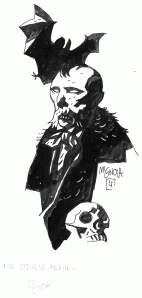Joshua Reynolds's Blog, page 14
December 2, 2021
Loup-Garou Kid
Who was that
dog-faced man? they asked, the day I rode
from town.
– Ishmael Reed, I Am a Cowboy in the Boat of Ra
I’ve said before that I have a handful of favourite poems, and Ishmael Reed’s ‘I Am a Cowboy in the Boat of Ra’ is at the top of that list. Do yourself a favour and read it. It’s like some sort of funky magical rite, an invocation to either an old god – or a new one.
I like it. I don’t know why. I read it a lot, especially when I’m in need of inspiration. I take it apart and focus in on certain bits – ‘I hold the souls of men in my pot’; ‘bring me my bones of Ju-Ju snake’; ‘Vamoosed from the temple, I bide my time’. It’s all good. Every line is a story, a chapter in a saga. Is it Osiris, returning from the dead? A sorcerer looking for his rival? Both, neither, something else entirely.
Maybe that’s why I like it so much. It’s every story and none.
Anyway, if you enjoy it, I also suggest you check out some of Reed’s other works, especially Yellow Back Radio Broke-Down and Mumbo Jumbo, both of which I regularly reread.
I am a cowboy in the boat of Ra. Lord of the lash,
the Loup Garou Kid. Half breed son of Pisces and
Aquarius. I hold the souls of men in my pot. I do
the dirty boogie with scorpions. I make the bulls
keep still and was the first swinger to grape the taste.
– Ishmael Reed, I Am a Cowboy in the Boat of Ra

December 1, 2021
LATEST NEWS
Below you’ll find all the latest news in regards to Josh’s work, including interviews, appearances and new releases. Check back regularly for updates!
LATEST FREE STORY

This month’s free story has just been posted to the blog! “Krampusnacht” is a tale of the Royal Occultist, and it finds him fighting against a Christmas horror out of legend. As always, it’s absolutely free to read, but if you enjoy it, please consider buying Josh a coffee.
LATEST INTERVIEW
Josh sits down with Anjuli to talk about Zombicide: Last Resort!
LATEST NOVEL
Zombicide: Last Resort is Josh’s first foray into the apocalyptic world of ZOMBICIDE. Join Westlake, Ramirez and El Calavera Santo as they battle undead park rangers and worse in the Adirondacks.

The zombie apocalypse has driven humanity up into the Adirondacks. Enter Westlake, a hardened career criminal on the path of “the Villa”, a legendary mafia hideout where he can escape the devastation. When he’s ambushed by the undead, an old FBI “friend” and his squad of survivors rescue him… and then force him to reveal his secrets. Reluctantly, Westlake is saddled with an oddball team to navigate minefields, trip wires, and flesh-eating zombies at every turn to find their safe haven…
Find Out MoreAmazon USAmazon UKLATEST SHORT STORY
“Bruno J. Lampini and the Sanguinary Assignation” is the fourth Bruno J. Lampini story to appear in print, and the wildest outing yet for the amoral acquisitionist of the eldritch!

Enter freely, and drink deeply of fifteen vampire tales told by a sanguinary collection of modern horror authors. Here you will find both traditional vampires, and those who stretch genre boundaries. Not all of these Nosferatu drink blood, but they all share an unholy thirst for human lives. So step into the shadows, and listen for the children of the night.
With Stories by:
Amanda DeWees
Donald F. Glut
John Linwood Grant
Leanna Renee Hieber
Paul McNamee
Chris McAuley
Lee Murray
Josh Reynolds
Cat Scully
Jeff Strand
Plus:
A new Sonja Blue story by Nancy A. Collins
A New Bubba the Monster Hunter story by John Hartness
A New Deacon Chalk story by James R. Tuck
A new Jonathan Crowley/Carter Decamp story by James A. Moore and Charles R. Rutledge
And introducing Renard Duvall in a story by Cliff Biggers
November 29, 2021
The Blind Man
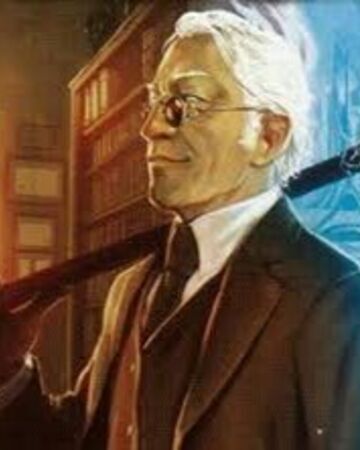
They are at the mouth of the Miskatonic now. But I am ready.
– Dr. Laban Shrewsbury, The House on Curwen Street, 1934
‘…an elderly man who wore his hair long and white…a firm, almost prognathous chin, half-pursed lips and a strong Roman nose. His eyes were not visible at all, for he wore dark glasses with shields which prevented one from seeing his eyes even from the side.’
Such is our first glimpse of Dr. Laban Shrewsbury, late of Arkham, late of the distant star Celaeno, and the Hyades in the 1944 story, “The House on Curwen Street”. Blind, and yet all-seeing, Shrewsbury stands between humanity and Lovecraft’s nightmarish god-things, employing weapons both material and supernatural in the world’s defense.
Created in 1944 by August Derleth for a series of interlinked stories set firmly in the dark universe of HP Lovecraft’s Cthulhu Mythos – a term coined by Derleth himself – Shrewsbury was far from the standard Lovecraftian protagonist. With his incantations and machinations, he is at first glance the antithesis of the hapless antiquarians and artists who populate both the original stories and many of the pastiches that came after.
Shrewsbury is far more active than his predecessors, who are, in most cases, passive victims of the horrors they encounter. Unlike John Kirowan, who has seen the audient void and been frightened by it into a haunted and semi-reclusive retirement, Shrewsbury is more akin to Anton Zarnak – an active combatant in a war in which humanity is, at best, a pawn and at worst, food for the titanic forces at play.
In digging further, one finds a clear link between Shrewsbury and characters such as Inspector Legrasse. Indeed, Shrewsbury could be seen as a figurative descendant of Legrasse; in Shrewsbury, with his grotesque scars, esoteric knowledge and inhuman cunning, we have the end result of Legrasse’s Quixote-like tilting at eldritch windmills. Shrewsbury, by his own admittance, was nothing more than an anthropologist and professor of philosophy at Miskatonic University before, like Legrasse, stumbling across the unknown and unmentionable and paying the price.
In Shrewsbury’s case, the price was physical as well as mental: his eyes were plucked from his head and his body was scarred by the tortures of his enemies. Sightless and spiritually hardened by his experiences, Shrewsbury has become a man with a mission, a mission which takes he and his at-times unwitting accomplices through the five stories which would eventually be collected under the title of The Trail of Cthulhu in 1962 by Arkham House.
The stories – “The House on Curwen Street”, “The Watcher from the Sky”, “The Gorge Beyond Salapunco”, “The Keeper of the Key” and “The Black Island” – appeared between 1944 and 1952 in Weird Tales, and chronicled Shrewsbury and company‘s attempts to stymie the machinations of the Cthulhu Cult, and, in the final story, to destroy the eponymous monstrosity itself with the help of the US Navy and a nuclear weapon.
As might be guessed, there is more than a whiff of the pulp hero about Shrewsbury. He does not merely consult alien tomes and necromantic grimoires, but has written them. Blessed with psychic sensitivity, he bellows incantations and summons demonic steeds with the regularity of Doc Savage unleashing technological gimmicks. He is engaged in a guerrilla war against a vast cosmic conspiracy, always escaping moments ahead of batrachians assassins and mammoth undersea monstrosities, retreating to his Fortress of Solitude in Celaeno to plan new campaigns against his eternal enemies.
And they are eternal. Lovecraft’s monstrous Old Ones, even when filtered through Derleth’s dualism are inimical and immortal forces of nature and Shrewsbury can, at best, hold them at bay. His struggle, waged by clandestine means across the span of the five stories that make up The Trail of Cthulhu, is one of futility in the face of omnipotence; gnats trying to kill giants. Despite (or perhaps because of) Shrewsbury’s pulp hero sheen, his struggles against forces that even his alien-enhanced intellect can only dimly comprehend are tinged with a fatalistic desperation.
Unlike Zarnak or even Thunstone, who defeated their personal devils time and again, Laban Shrewsbury struggles on, outmatched, outnumbered and outgunned by his foes. Ringed about by dooms he cannot see the blind man battles on, tilting at the indescribable and inexorable to win but one minute more for humanity.
The Trail of Cthulhu is available from Amazon and a variety of online retailers, including eBay. However, it’s been out print for close to a decade, so, if you’re interested in reading it without breaking your bank account, it pays to do some delving. While it’s very much an acquired taste, like so much of Derleth’s work, it’s a fun story and worth a read.
*Author’s Note: This essay originally appeared in 2012, at Black Gate Magazine.*
November 25, 2021
Turkey Drop 2021
I’ve never been big on Thanksgiving, for a variety of reasons, but I have one tradition I refuse to break. Every Thanksgiving, whatever else is going on, whatever sort of mood I’m in or what sort of deadlines I’ve got looming, I watch the “Turkeys Away” episode of WKRP in Cincinnati.
You probably know what episode I’m talking about, because it’s the only episode of the series anyone really remembers – which is unfortunate, as WKRPiC is a comedy gem, and without it we possibly wouldn’t have had later workplace sitcoms, such as Newsradio, Wings, or even Parks & Rec. I highly recommend reading this oral history of the episode in question, over at The Classic TV History Blog.
All that aside, it’s well worth a watch if you’ve never seen it.
Just watch out for falling turkeys.

November 23, 2021
The Victorian Occultist
Today’s instalment of the Royal Occultist Compendium takes a look at a previous holder of the office – Edwin Drood.
Sir Edwin Drood had the honour to hold the position of Royal Occultist at the close of the nineteenth century. Elevated in the wake of Aylmer Beamish’s disappearance, Drood’s assumption of the post brought a return to respectability in the eyes of many. Scientist, philosopher and diplomat, Drood’s approach to the occult was one of rigorous discipline and precision. He first made a name for himself investigating certain abnormalities found in the aftermath of the Woolwich Pier Disaster of 1878 alongside Beamish, but went on to great success in the years following.
He made great strides in recording and cataloguing his various encounters with what he called the ‘ab-natural’, as well as anonymously disseminating that information to the public through the works of writers such as Robert Louis Stevenson and Bram Stoker. He was an early patron of the Society for Psychical Research, the London Spiritualist Alliance, the Ghost Club and a dozen others, working alongside notables such as Sir Arthur Conan Doyle and AA Watts.
Besides being a scientist and occultist, Drood displayed a number of extrasensory talents, including psychometry. It was this latter ability that necessitated his habit of wearing of gloves on most occasions and is rumoured to be the reason for his occasional visits to noted Harley Street alienist, Dr. Moore Agar, as well as more esoteric consultations with his peers, Dr. Martin Hesselius and Dr. John Silence. Drood’s constitution, never the most robust, suffered markedly as his tenure progressed.
Despite this persistent weakness, it was Drood who, along with several others, defeated the vampiric invader known as Dracula, as well as the malign tulpa calling itself Hyde. He even disrupted the schemes of secret societies such as the Order of the Golden Dawn and the Sisterhood of Rats. Perhaps his most infamous exploit occurred during Queen Victoria’s Diamond Jubilee, when he dispatched the monstrous Creeping Man before the eldritch being could throttle Victoria herself.
His exploits filled the pages of The Idler and other publications, though Drood himself disapproved of sensationalism. Drood vanished under mysterious circumstances sometime at the close of the nineteenth century, leaving his duties – as well as a sizeable inheritance – to his apprentice, Thomas Carnacki.
Rumours surrounding his whereabouts and possible fate persisted into the 1920s, including sightings of a man resembling Drood’s description in a certain garret in Soho, as well as around Cheyne Walk and the Embankment. These sightings tapered off towards the end of 1925, and there has since been no further sign of Edwin Drood – dead or alive.
Drood has appeared in only two stories – “The Disagreeable Bridegroom” and “The Pnakotic Puzzle”. While the shadow he casts is not so long as that of some, he is nonetheless an important figure in the annals of the Royal Occultist and he’s one of my favourite characters in the series. He’s every Victorian adventurer – Alan Quatermain, Professor Van Helsing and Sexton Blake, etc. – rolled into one stuffy, stolid figure. His mysterious final fate is explained in “The Pnakotic Puzzle”, which, I think, sends him out on an appropriately heroic note.
I have ideas for other stories about him (including one dealing with the aforementioned ‘abnormalities near Woolwich Pier’), but I haven’t quite gotten around to writing any of them beyond a few stray bits and pieces. Maybe one day.
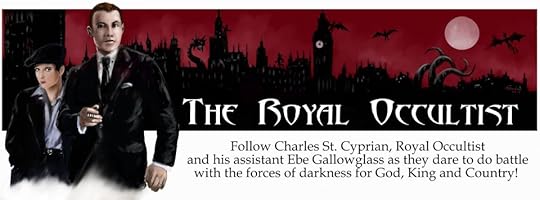
November 19, 2021
A Dreadful Emptiness

Just a pinpoint monsieur. In a flower. Or perhaps in a glass of wine.
– Murder Legendre
Murder Legendre is well named. Perhaps the most well-named character ever portrayed by the redoubtable Bela Lugosi. He is the Faustian influence at the heart of 1932’s White Zombie, the dark star around which the rest of the cast orbits. A figure of unholy potency, Legendre rests somewhere between Count Dracula’s predatory aristocracy and the proletarian grotesquery of Frankenstein’s unfortunate creation. A pragmatic man, he cheerfully draws up the dead and sets them to labour in service of the living – for a price. He damns his victims for spite, motivated by a petty malice that is both monstrous and all too human.
Filmed in under a fortnight, White Zombie nonetheless boasts impressive production values. Reusing sets from films such as Dracula (1931) and The Hunchback of Notre Dame (1923), and employing inventive camera effects, director Victor Halperin creates a pervasive gothic atmosphere that allows Lugosi’s one note but iconic Legendre to dominate the short running time. Lugosi is firing on all cylinders here, and his eerie magnetism is plainly evident in his first appearance, stalking through a graveyard with a coterie of dead men in tow – not to mention the numerous, sinister closeups provided by cinematographer Arthur Martinelli.
It’s a stately film; timeless despite being ostensibly set in the year of its debut. There’s a fairy tale quality about it – a sort of whimsical diabolism that periodically intrudes on the viewer’s attentions, most notably in a scene in which a zombie worker topples soundlessly into a cane shredder as his heedless companions continue their labours. And Legendre himself is quick to inflict his sense of humour on others – his dialogue is filled with pointed asides and bleak jests; he contrasts the fallible living with the obedient dead and it is clear whose company he prefers.
Above, I made use of the term Faustian. There is something of a Faust about Legendre – a dreadful emptiness that can never be satisfied. Not by his magics or the money of his victims. He has a yawning tomb where his soul should be, and he seeks to fill it with a rapaciousness that would give even Dracula pause. Yet like Dracula, Legendre cannot be sated.
His hunger – for respect, for power – dominate his every waking moment and drive his every action. Every move he makes is one of grasping, greedy need. He is like a cold fire, raging across the island he rules in all but name, taking whatever he wishes but finding no satisfaction in the act. The more he takes, the more he needs. The more he needs, the more he is driven to take. He wants power, but it is not enough. He wants respect, but finds that it pales in comparison to love – so desires to claim that for himself as well. But he does not understand it, and so acquires only an unsatisfying parody of the thing.
Legendre is as much a slave as his servants but unlike them, he shows the occasional flicker of self-awareness – a wry smile as he contemplates the limits of his power, a look of annoyance with his self-pitying ally, the sugar-planter, Beaumont. You can see the wheels turning behind Lugosi’s devilish countenance as he realizes the trap he has set for himself. But this realization only feeds his pettiness. A refused handshake early in the film is enough to drive him to turning on his partner in crime at the climax, an event that leads to his own eventual undoing when his concentration is broken and he is hurled from the parapet of his own castle.
Fitting, in a way.
By his own hand was Legendre raised up, and it is by his own hand that he is dashed down into the roaring emptiness of the sea – consumed by a hunger even greater than his own.
November 17, 2021
The Haunted Wanderer
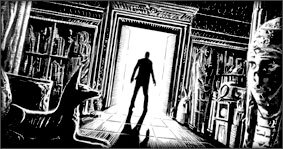
I know the price a man must pay for calling forth the nameless shape that roams the gulfs of darkness.
– John Kirowan, The Haunter of the Ring, 1934
While Robert E. Howard is perhaps best known for creating Conan, he had his share of occult investigators of one stripe or another. There was Steve Harrison of River Street, Solomon Kane with his fiery Puritanism and cat-headed ju-ju staff and, of course, John Kirowan.
Kirowan is of an age and appearance with a number of Howard’s other characters, being tall, slender, brooding, and black haired-a Celt of the modern age. Sorrow hangs about him like a shroud, and his history is tragic. Though few agree on what form said tragedy might have taken, all believe that it has something to do with the years that he spent studying the occult arts in the black hills on Hungary and the secret places of Inner Mongolia.
What is known for certain is that Kirowan renounced these studies, and assumed the guise of a sceptic. But, when the nightmarish denizens of diabolical realms intrude upon the lives of his friends and companions, John Kirowan shows his true colours, and the haunted wanderer once more thrusts himself between the innocent and the devils in the dark.
Kirowan appeared in six stories between 1931 and 1986-“The Children of the Night” (1931), “The Haunter of the Ring” (1932), “Dig Me No Grave” (1937), “Dermod’s Bane” (1967), “The Dweller Under the Tombs” (1967) and “Dagon Manor” (1986).
While the first two appeared in Weird Tales during Howard’s lifetime, the final four were posthumously published by various magazines. Of those, the last, “Dagon Manor” (1986), was a beyond-the-grave collaboration between Howard and CJ Henderson, a man with his own impressive line-up of occult detectives, and based on an unfinished fragment of Howard’s. A seventh story, “The Thing on the Roof” (1932), is often included in the list, though it’s unclear whether the narrator is meant to be John Kirowan, or his occasional amanuensis, John Conrad.
Conrad is a curious feature of the Kirowan stories. It’s obvious he’s meant to play Watson to Kirowan’s Holmes (or more likely the Dr. Trowbridge to Kirowan’s De Grandin), but Conrad is in many ways a reflection of Kirowan, rather than a sidekick. Conrad is a dedicated occult aspirant, hunting for lost lore and engaging in magical folly as Kirowan himself once did. Reading the stories, one gets the impression that Kirowan is, in a sense, attempting to steer his more impetuous friend into less hostile waters. Kirowan, after all, has seen what waits at the end for those who walk the occult road, and knows better than anyone the price that must eventually, inevitably be paid.
Unlike many occult detectives, Kirowan is, at best, a reluctant hero. In many ways, he reminds the reader of the archetype of the retired gunfighter, who refuses to strap on his guns until the final reel, when he once more must take up his pistols and deal certain death to those who have pushed him to the point of no return. And like the gunfighter, Kirowan on the prod is a terrible sight to behold, prone to the berserk ferocity and ruthless abandon that was the hallmark of many of Howard’s characters, though with far more unpleasant consequences.
By and large, however, Kirowan hugs the background of his stories, letting Conrad do most of the talking. The two men share an interesting symbiosis, with Kirowan generally content to stay out of whatever dark occurrence has reared its head until Conrad gets him involved, usually by getting into trouble himself. Kirowan is a reluctant hero, and given the world he lives in, it’s easily understandable why.
Kirowan, as a character, exists firmly rooted within HP Lovecraft’s Cthulhu Mythos, with all of the nihilistic horror that that entails. Kirowan, alone among his friends, knows what horror huddles behind the mask of yellow silk worn by the High-Priest-Not-To-Be-Named and what obscene battle is marked at the site of the Black Stone. Kirowan knows what unseen hands strangled Von Junzt in his locked room for he has felt them on his own neck. Is it any wonder that he’s a grim and melancholy soul?
In effect, Kirowan is a sad sort of figure…a man burdened by his knowledge, and one who understands that what he knows could easily lead to death for those he associates with. His only solace and human companionship is found within the eccentric and esoteric halls of the Wanderer’s Club, where he hides from society at large and buries himself in study, refusing to acknowledge the darkness that surrounds him until there is no other option.
Indeed, so reluctant is Kirowan that he plays the hard-nosed sceptic in most matters. He conceals his knowledge behind a mask of disbelief and (perhaps not entirely) feigned distaste, sniping and snapping at those who seek his help like a cranky mystic in a questing tale. But when the menace becomes unavoidable, he ceases playacting and gets down to business. There’s a bit of John Silence about Kirowan at these points; a sort of otherworldly poise that comes into play at the climax of the stories.
Like Silence, Kirowan possesses preternatural senses and a knowledge and iron will that far outstrips that of his more adventurous companions and these, rather than scientific tricks or occult paraphernalia, are his tools in confronting the unnatural. Kirowan faces down the horrors in the dark as only one familiar with them can, refusing to blink even as the horrors advance on all sides.
If you’re interested in reading the stories for yourself, several of them are freely available on Project Gutenberg Australia, and all of them are collected in The Horror Stories of Robert E. Howard from Del Rey.
*Author’s Note: This essay originally appeared in 2012, at Black Gate Magazine.*
November 15, 2021
Tenebre
This one is based on a snippet of nothing I came up with a few years ago, about a town sunk into a swamp and a painter by the name of Tenebre. The town – and its inhabitants – have been mentioned or appeared in several of my stories, most notably “Night Falls on Tenebre” and “Tenebre Dark”. One day I might revisit Tenebre and its cursed inhabitants (I had an idea for a horror novel set there), but probably not anytime soon.
The bridge to Tenebre is still there, even if Tenebre ain’t. It’s covered in kudzu and eaten through by termites, but it still spans the Saxon River. What’s left might last a week or a hundred years. Probably somewhere in between.
No one crosses the river where the bridge sits nowadays, not after old Tenebre was flooded by the county to make way for the new reservoir, and new Tenebre…vanished. Or mostly did. Some folks blame the flood of ’68, when the Saxon swelled so black and deep that the birds drowned and the fish learned to fly. And it’s true enough. New Tenebre had been built at the water’s edge – too close, according to those who knew about such things – and when the flood hit, it was first in line after the new reservoir cracked wide open.
But other folks know better. Those folks who lived closest to old Tenebre, and knew what went on there, beneath the dark oaks. There was a sickness, they said. A deep, abiding rot that hid in the marrow of every man, woman and child in that place. A sickness that claimed them one by one, until only a pitiful few were left to vanish when the county moved them on.
There’s only a few houses from the new town left on that muddy shore opposite the remnants of the reservoir, but no one knows what’s in them. There’s no reason to go.
Too dangerous to go, really.
There are still things in Tenebre, folks whisper. Not people. Not anymore. Maybe they never were. Regardless, most folks know the water keeps them things back, keeps them contained. But the bridge…well, that’s a sticking point.
Bridges, y’see, are invitations. And them things that live in Tenebre, they wait for invitations. So the bridge was left to rot. A dead bridge is a failed invitation. A hand half-extended. There’s a way these things work, and a way they don’t, and everyone, alive or dead, knows it.
So the bridge sits and rots and on the other side among the low-hanging trees that hide the empty houses of Tenebre, things wait. And watch. They watch the bridge. Sooner or later, someone will make that invitation again.
Some people can’t leave well enough alone.
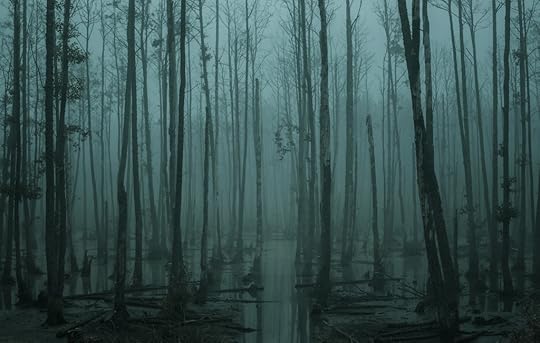
November 11, 2021
Rattle-Bone Wire
This one is based on a thing my father once showed me, way back a few years ago. A wire fence, stretching across a property line, studded with animal bones and tiny flags. No reason for it that I could see. It seemed too odd not to turn into something.
So here’s something.
The Rattle-Bone Wire hung on the edge of Saxon land, down near the pond and the road of the same name.
It marked the boundary of Saxon land. Still does, as a matter of fact. It stretches from Cornsnake Road over to Callygar, and every inch of it is twined with bones. Some bleached, some brown.
Some white as new-fallen snow.
Nobody knew why the bones where there. Nobody except the Saxons and nobody could get a word out of them half-ways understandable. They replaced the bones when one fell off, though where they got the new bones no one asked. And they added to it constantly, so much so that the wire was more a bone-wall than fence at times.
There was a rumor that cropped up from time to time that not all the bones were deer or cows or hogs. Some of them were too long, too straight. Those rumors never went far. The law didn’t go onto Saxon land. Not one toe, not one inch. So the rumors would fade and go dark for a bit until some hunter caught sight of the bone-wire again and saw a jawbone that didn’t quite look right or a femur that was too long. Then the whispers would start all over again.
It was said, by those as who had been, that whenever an outsider stepped over the bone-wire, it would begin to click and clack, as if a strong wind had come up. Only there never was no wind. But them bones clickity-clacked all the same. That’s why folks took to calling it the Rattle-Bone Wire, I suppose.
But you’d have to ask the Saxons to be sure.

November 8, 2021
The Night Has Teeth
Today is Bram Stoker’s birthday, which is probably as good a time as any to draw another corpse from its grave. This is a brief essay about Dracula and his popularity that I wrote several years ago. I think it still holds up, so here it is again.
Dracula.
If there were just one word to sum up the concept of ‘evil’, it would likely be Dracula.
In the pantheon of western literature’s best and brightest villains, Dracula sits high on some dark Olympus, if not at the apex, then comfortably close. Barely on screen in Bram Stoker’s eponymous novel for more than a few chapters, nonetheless it is Dracula who drives the book. It is Dracula who drives the films which bear his name, who drives the action in every appearance.
He’s the sort of antagonist that brings out the best in a hero, which may account some for his popularity. He’s all of humanity’s fears and hates and loathing rolled up into one handy package. He embodies themes as varied as cannibalism, rampant sexuality, the ‘other’ and the fear of death and the dead, as well as more esoteric concepts (the Faustian bargain, necromancy, plague, taboo animals, etc.).
But is that all there is to it? Just some smelly themes and subconscious symbolism?
No. Dracula is the outsider, always scratching at our door, looking for a way in. The thing at the back of the cave, or waiting in the forest. The omnipresent Night, with teeth. The themes and symbols which trail after him like a cloak are but manifestations of his ultimate identity-that of the Thing That Scares Us.
It’s why we go back to him, again and again, much as his victims did. We invite him in, even knowing what he is, foul breath and all. We invite him in with books and films and plays and all variety of entertainments, pitting him against ourselves and our archetypes (Dracula Vs. Sherlock Holmes, Dracula Vs. Billy the Kid, Dracula Vs. Superman, etc.), destroying him again and again, but like the Night, he always returns. We mock him in cartoons and commercials, we make him into comic books and video-games, but the savagery never diminishes, the fear never entirely goes away.
It’s the fear that we can’t do without. The terror of being hunted. We can’t forget it, even with all of evolution at our back, with our science and religion and civilization. Some part of us always remembers the cave, and thing that we saw there, waiting to pounce out of the darkness.
We can’t get rid of him, just like we can’t rid ourselves of the atavistic fears handed down by our primordial ancestors. No matter how much we try to dislodge him, to remake him or remould him, Dracula clings to us, he is in the back of our head.
In our blood.
